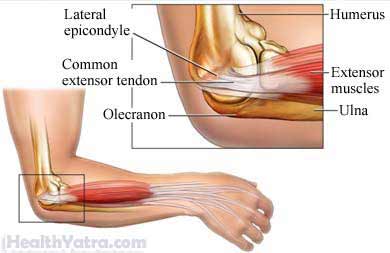Definition
An elbow sprain is stretching or tearing of the ligaments that stabilize the elbow. Ligaments are strong bands of tissue that cross joints and connect bones to each other.

Causes
Elbow sprains may be caused by:
- Forced twisting of the arm
- Falling on an outstretched arm
- A blow to the elbow
Risk Factors
A risk factor is something that increases your chance of getting a disease, condition, or injury.
Risk factors for an elbow sprain:
- Playing certain sports, such as gymnastics
- Poor coordination
- Poor balance
- Inadequate flexibility and strength in muscles and ligaments
- Loose joints
Symptoms
Symptoms include:
- Pain, tenderness, and swelling around the elbow
- Redness, warmth, or bruising around the elbow
- Limited ability to move the elbow
- Pain when moving the elbow
If you felt your elbow dislocate (or “pop” out of the joint), tell your doctor right away. The treatment for a dislocation is different than a sprain.
Diagnosis
The doctor will ask about your symptoms and how you injured your elbow. The doctor will examine your elbow to assess the stability of the joint and the severity of the injury.
Note:
Tests may include:
- X-rays —a test that uses radiation to take a picture of structures inside the body, especially the bones. You may have an x-ray to make sure that no bones are broken.
- MRI scan—a test that uses magnetic waves to make pictures of structures inside the body. You might have a scan to see if a ligament has torn completely (but rarely needed).
Elbow sprains are graded according to their severity.
Grade1
- Stretching and some microtearing of ligament tissue
Grade 2
- Partial tearing of ligament tissue
- Mild instability of the joint
Grade 3
- Severe or complete tearing of ligament tissue
- Significant instability of the joint
Treatment
Treatment includes:
- Rest—Avoid using your injured arm.
- Ice—Apply ice or a cold pack to the elbow for 15-20 minutes, four times a day for several days. This helps reduce pain and swelling. Wrap the ice or cold pack in a towel. Do not apply the ice directly to your skin.
- Compression—Wrap your elbow in an elastic compression bandage (such as, an Ace bandage). This will limit swelling and support your elbow. Be careful not to wrap your elbow too tightly, which could compromise the circulation.
- Oral pain medicine (such as, ibuprofen, naproxen, acetaminophen, aspirin) and topical pain medicines (such as, creams, patches) that are applied to the skin
- Sling—You may need to wear a sling to immobilize your arm and elbow.
- Cast—If you have a severe sprain, your doctor may recommend a cast or splint for 2-3 weeks.
- Rehabilitation exercises—Begin exercises to restore the range of motion and strength in your elbow as recommended by your healthcare professional.
- Surgery—Surgery is not needed to repair an elbow sprain. However, in rare cases, surgery may be needed to repair a ligament that is torn completely.
Prevention
Elbow sprains usually occur from accidents that cannot be prevented.
Keywords :
Elbow Sprain Definition, Elbow Sprain Causes, Elbow Sprain Symptoms, Elbow Sprain Complications, Elbow Sprain Surgery Cost in India, Elbow Sprain Treatment Hospital in India, Elbow Sprain Treatment in India, Elbow Sprain Doctors in India, Elbow Sprain Meaning in Hindi, Elbow Sprain Meaning in Bengali, Elbow Sprain Meaning in Arabic, Elbow Sprain Treatment cost in 2024, Elbow Sprain Hospital in India, Elbow Sprain Treatment Near Me, elbow sprain treatment, symptoms of a sprained elbow, sprain elbow recovery time, elbow sprain exercises, can you sprain your elbow by falling on it, elbow sprain causes, elbow strain vs sprain, can a sprained elbow heal on its own,
